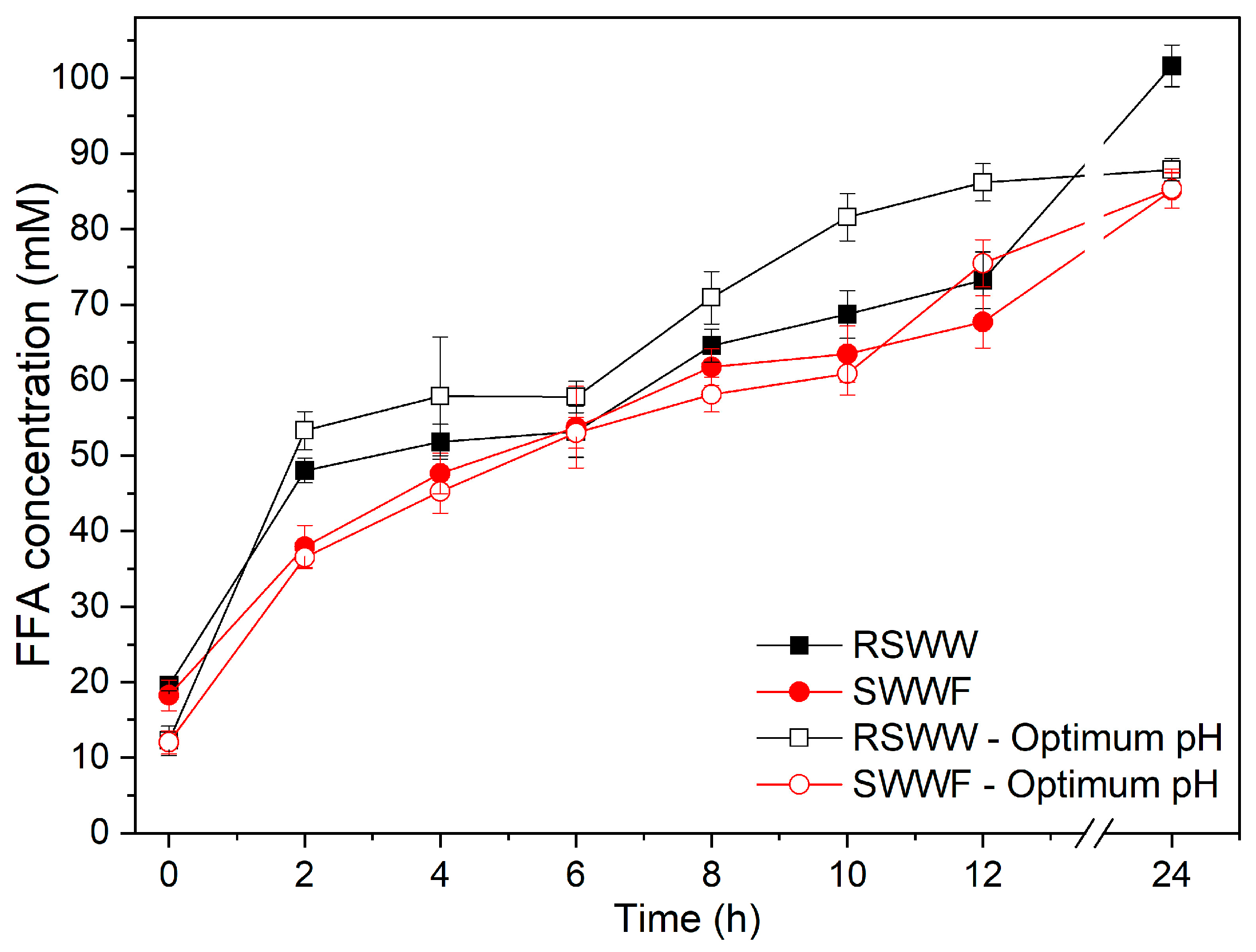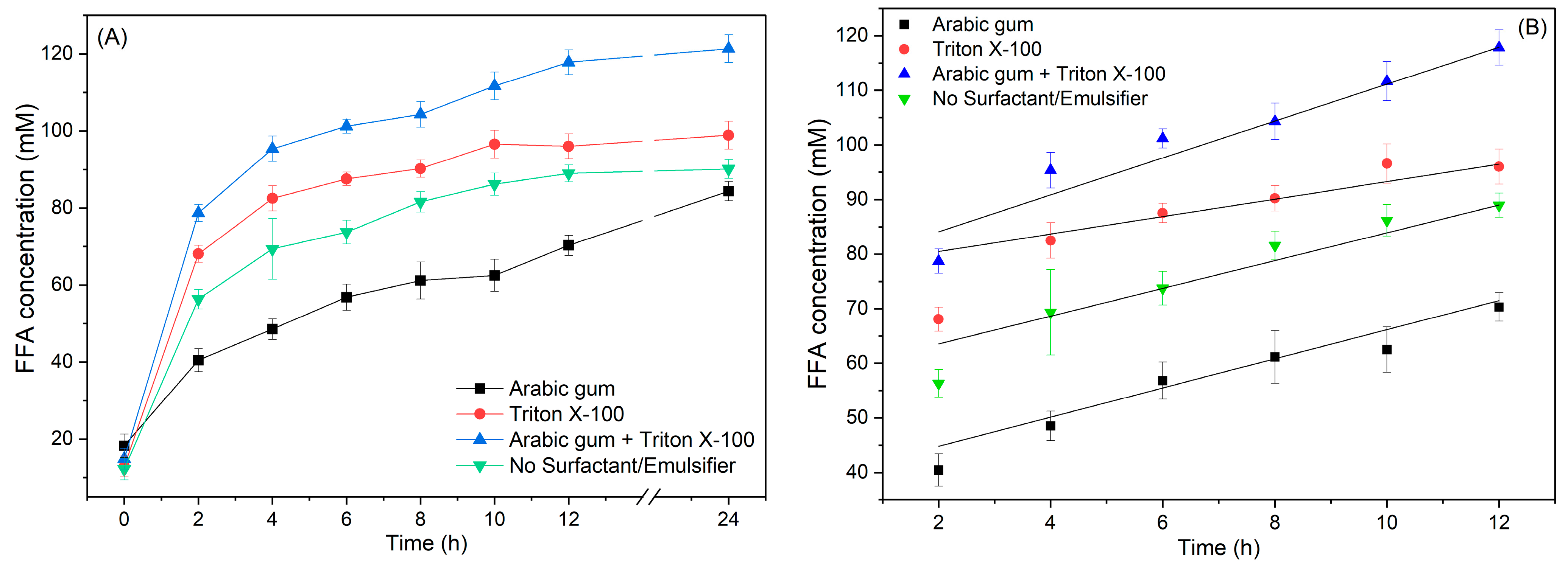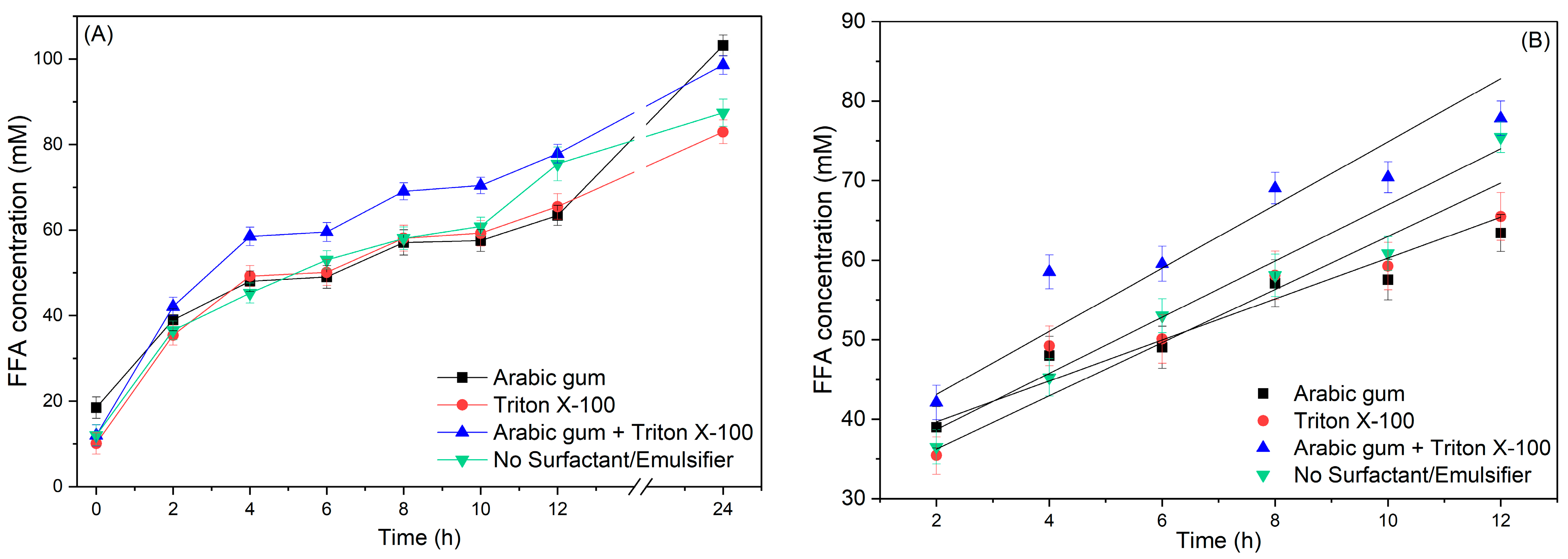Enzymatic Pretreatment of Slaughterhouse Wastewater: Application of Whole Lipolytic Cells of Rhizopus oryzae Produced from Residual Vegetable Oil
Abstract
1. Introduction
2. Materials and Methods
2.1. Microorganism
2.2. Materials
2.3. Physicochemical Characterization of SWW
2.4. Enzymatic Activity
2.5. Culture Medium and Conditions
2.6. Enzymatic Pretreatment of Slaughterhouse Wastewater in Stirred Tank Reactors
2.7. Variation in Biomass Mass during the Enzymatic Pretreatment of Slaughterhouse Wastewater
2.8. Evaluation of pH Adjustment in the Enzymatic Pretreatment of SWW
2.9. Influence of Surfactants and Emulsifiers on the Enzymatic Pretreatment of SWW
3. Results and Discussion
3.1. Characterization of Slaughterhouse Wastewater
3.2. The Influence of Biocatalyst Mass on the Hydrolysis of Slaughterhouse Wastewater
3.3. Influence of the Initial pH of Slaughterhouse Wastewater on the Hydrolysis Process
3.4. Influence of Surfactants and Emulsifiers on the Enzymatic Pretreatment
4. Conclusions
Author Contributions
Funding
Data Availability Statement
Conflicts of Interest
References
- Lee, S.Y.; Stuckey, D.C. Separation and biosynthesis of value-added compounds from food-processing wastewater: Towards sustainable wastewater resource recovery. J. Clean. Prod. 2022, 357, 131975. [Google Scholar] [CrossRef]
- OECD/FAO. OECD-FAO Agricultural Outlook 2022–2031; OECD Publishing: Paris, France, 2022. [Google Scholar] [CrossRef]
- Al-Gheethi, A.; Ma, N.L.; Rupani, P.F.; Sultana, N.; Yaakob, M.A.; Mohamed, R.M.S.R.; Soon, C.F. Biowastes of slaughterhouses and wet markets: An overview of waste management for disease prevention. Environ. Sci. Pollut. Res. 2021, 1–14. [Google Scholar] [CrossRef] [PubMed]
- Chowdhury, M.W.; Nabi, M.N.; Arefin, M.A.; Rashid, F.; Islam, M.T.; Gudimetla, P.; Muyeen, S.M. Recycling slaughterhouse wastes into potential energy and hydrogen sources: An approach for the future sustainable energy. Bioresour. Technol. Rep. 2022, 19, 101133. [Google Scholar] [CrossRef]
- Bustillo-Lecompte, C.F.; Mehrvar, M. Slaughterhouse wastewater characteristics, treatment, and management in the meat processing industry: A review on trends and advances. J. Environ. Manag. 2015, 161, 287–302. [Google Scholar] [CrossRef]
- Ramadan, L.; Deeb, R.; Sawaya, C.; El Khoury, C.; Wazne, M.; Harb, M. Anaerobic membrane bioreactor-based treatment of poultry slaughterhouse wastewater: Microbial community adaptation and antibiotic resistance gene profiles. Biochem. Eng. J. 2023, 192, 108847. [Google Scholar] [CrossRef]
- Aziz, A.; Basheer, F.; Sengar, A.; Khan, S.U.; Farooqi, I.H. Biological wastewater treatment (anaerobic-aerobic) technologies for safe discharge of treated slaughterhouse and meat processing wastewater. Sci. Total Environ. 2019, 686, 681–708. [Google Scholar] [CrossRef] [PubMed]
- Cheng, D.; Liu, Y.; Ngo, H.H.; Guo, W.; Chang, S.W.; Nguyen, D.D.; Zhang, S.; Luo, Y.; Liu, Y. A review on application of enzymatic bioprocesses in animal wastewater and manure treatment. Bioresour. Technol. 2020, 313, 123683. [Google Scholar] [CrossRef] [PubMed]
- Jankowska, E.; Sahu, A.K.; Oleskowicz-Popiel, P. Biogas from microalgae: Review on microalgae’s cultivation, harvesting and pretreatment for anaerobic digestion. Renew. Sustain. Energy Rev. 2017, 75, 692–709. [Google Scholar] [CrossRef]
- Vasco-Correa, J.; Khanal, S.; Manandhar, A.; Shah, A. Anaerobic digestion for bioenergy production: Global status, environmental and techno-economic implications, and government policies. Bioresour. Technol. 2018, 247, 1015–1026. [Google Scholar] [CrossRef]
- Bhunia, S.; Bhowmik, A.; Mukherjee, J. Waste management of rural slaughterhouses in developing countries. In Advanced Organic Waste Management; Elsevier: Amsterdam, The Netherlands, 2022; pp. 425–449. [Google Scholar] [CrossRef]
- Cammarota, M.C.; Freire, D.M.G. A review on hydrolytic enzymes in the treatment of wastewater with high oil and grease content. Bioresour. Technol. 2006, 97, 2195–2210. [Google Scholar] [CrossRef]
- Valladão, A.B.G.; Torres, A.G.; Freire, D.M.G.; Cammarota, M.C. Profiles of fatty acids and triacylglycerols and their influence on the anaerobic biodegradability of effluents from poultry slaughterhouse. Bioresour. Technol. 2011, 102, 7043–7050. [Google Scholar] [CrossRef] [PubMed]
- Palatsi, J.; Affes, R.; Fernandez, B.; Pereira, M.A.; Alves, M.M.; Flotats, X. Influence of adsorption and anaerobic granular sludge characteristics on long chain fatty acids inhibition process. Water Res. 2012, 46, 5268–5278. [Google Scholar] [CrossRef]
- Carrere, H.; Antonopoulou, G.; Affes, R.; Passos, F.; Battimelli, A.; Lyberatos, G.; Ferrer, I. Review of feedstock pretreatment strategies for improved anaerobic digestion: From lab-scale research to full-scale application. Bioresour. Technol. 2016, 199, 386–397. [Google Scholar] [CrossRef]
- Nimkande, V.D.; Bafana, A. A review on the utility of microbial lipases in wastewater treatment. J. Water Process Eng. 2022, 46, 102591. [Google Scholar] [CrossRef]
- Radha, P.; Prabhu, K.; Jayakumar, A.; AbilashKarthik, S.; Ramani, K. Biochemical and kinetic evaluation of lipase and biosurfactant assisted ex novo synthesis of microbial oil for biodiesel production by Yarrowia lipolytica utilizing chicken tallow. Process Biochem. 2020, 95, 17–29. [Google Scholar] [CrossRef]
- Alves, A.M.; de Moura, R.B.; Carvalho, A.K.; de Castro, H.F.; Andrade, G.S. Penicillium citrinum whole-cells catalyst for the treatment of lipid-rich wastewater. Biomass Bioenergy 2019, 120, 433–438. [Google Scholar] [CrossRef]
- Rice, E.W.; Bridgewater, L.; American Public Health Association (Eds.) Standard Methods for the Examination of Water and Wastewater; American Public Health Association: Washington, DC, USA, 2012; Available online: https://www.standardmethods.org/doi/book/10.2105/SMWW.2882 (accessed on 1 November 2023).
- AOCS Press. AOCS-American Oil Chemists’ Society Official Methods and Recommended Practices of the AOCS, 5th ed.; AOCS Press: Champaign, IL, USA, 2004; Available online: https://www.aocs.org/attain-lab-services/methods?SSO=True (accessed on 1 November 2023).
- De Castro, T.F.; Cortez, D.V.; Gonçalves, D.B.; Bento, H.B.; Gonçalves, R.L.; Costa-Silva, T.A.; Gambarato, B.C.; de Carvalho, A.K.F. Biotechnological valorization of mycelium-bound lipase of Penicillium purpurogenum in hydrolysis of high content lauric acid vegetable oils. Process Saf. Environ. Prot. 2022, 161, 498–505. [Google Scholar] [CrossRef]
- Lima, J.A.M.; Magalhães Filho, F.J.C.; Constantino, M.; Formagini, E.L. Techno-economic and performance evaluation of energy production by anaerobic digestion in Brazil: Bovine, swine and poultry slaughterhouse effluents. J. Clean. Prod. 2020, 277, 123332. [Google Scholar] [CrossRef]
- De Nardi, I.R.; Fuzi, T.P.; Del Nery, V. Performance evaluation and operating strategies of dissolved-air flotation system treating poultry slaughterhouse wastewater. Resour. Conserv. Recycl. 2008, 52, 533–544. [Google Scholar] [CrossRef]
- Duarte, J.G.; Silva, L.L.S.; Freire, D.M.G.; Cammarota, M.C.; Gutarra, M.L.E. Enzymatic hydrolysis and anaerobic biological treatment of fish industry effluent: Evaluation of the mesophilic and thermophilic conditions. Renew. Energy 2015, 83, 455–462. [Google Scholar] [CrossRef]
- Qiao, H.; Zhang, F.; Guan, W.; Zuo, J.; Feng, D. Optimisation of combi-lipases from Aspergillus niger for the synergistic and efficient hydrolysis of soybean oil. Anim. Sci. J. 2017, 88, 772–780. [Google Scholar] [CrossRef]
- Valladão, A.B.G.; Freire, D.M.G.; Cammarota, M.C. Enzymatic pre-hydrolysis applied to the anaerobic treatment of effluents from poultry slaughterhouses. Int. Biodeterior. Biodegrad. 2007, 60, 219–225. [Google Scholar] [CrossRef]
- Braz, C.A.; Carvalho, A.K.; Bento, H.B.; Reis, C.E.; De Castro, H.F. Production of value-added microbial metabolites: Oleaginous fungus as a tool for valorization of dairy by-products. BioEnergy Res. 2020, 13, 963–973. [Google Scholar] [CrossRef]
- Damasceno, F.R.; Cammarota, M.C.; Freire, D.M. The combined use of a biosurfactant and an enzyme preparation to treat an effluent with a high fat content. Colloids Surf. B Biointerfaces 2012, 95, 241–246. [Google Scholar] [CrossRef] [PubMed]
- Matias, A.B.; de SM Reis, W.; Costa-Silva, T.A.; Bento, H.B.; de Carvalho, A.K.; Pereira, E.B. Mycelium-bound lipase as skillful biocatalysts: Production of fatty acid concentrates from waste oils for the food industry. Catal. Commun. 2023, 184, 106787. [Google Scholar] [CrossRef]
- Ferreira, T.F.; Santos, P.A.; Paula, A.V.; de Castro, H.F.; Andrade, G.S. Biogas generation by hybrid treatment of dairy wastewater with lipolytic whole cell preparations and anaerobic sludge. Biochem. Eng. J. 2021, 169, 107965. [Google Scholar] [CrossRef]




| Parameter | RSWW | SWWF |
|---|---|---|
| pH | 6.15 ± 0.06 | 7.59 ± 0.35 |
| Total solids (mg L−1) | 18,609.17 ± 661.98 | 13,530 ± 1300.34 |
| Total fixed solids (mg L−1) | 3665.83 ± 195.26 | 2545.33 ± 139.91 |
| Total volatile solids (mg L−1) | 14,943.33 ± 698.49 | 10,984.67 ± 57.18 |
| Free fatty acids (%) | 0.75 ± 0.031 | 0.51 ± 0.023 |
| Acidity index (mgKOH g−1) | 1.64 ± 0.689 | 1.11 ± 0.051 |
| Saponification (mgKOH g−1) | 5.38 ± 0.39 | 4.32 ± 0.77 |
| Fatty acids composition (%) | ||
| Caprylic acid—C8:0 | 4.30 | - |
| Myristic acid—C14:0 | 4.49 | - |
| Palmitic acid—C16:0 | 30.00 | 30.71 |
| Stearic acid—C18:0 | 0.34 | - |
| Oleic acid—C18:1 | 31.30 | 35.92 |
| Linoleic acid—C18:2 | 29.56 | 33.37 |
| Average molecular weight of FFAs (g mol−1) | 273.79 | 265.68 |
| SWW—Pre-Flotator | Maximum FFA Concentration (mM) | v (mM/h) |
|---|---|---|
| Arabic gum | 107.11 ± 0.50 | 2.66 |
| Triton X-100 | 84.34 ± 1.60 | 1.60 |
| Arabic gum + Triton X-100 | 121.38 ± 1.63 | 3.38 |
| No surfactant/emulsifier | 90.14 ± 0.48 | 2.55 |
| SWW—Flotator | Maximum FFA Concentration (mM) | v (mM/h) |
|---|---|---|
| Arabic gum | 103.17 ± 0.40 | 2.57 |
| Triton X-100 | 82.95 ± 0.15 | 3.34 |
| Arabic gum + Triton X-100 | 98.59 ± 0.15 | 3.38 |
| No surfactant/emulsifier | 87.43 ± 2.59 | 3.53 |
Disclaimer/Publisher’s Note: The statements, opinions and data contained in all publications are solely those of the individual author(s) and contributor(s) and not of MDPI and/or the editor(s). MDPI and/or the editor(s) disclaim responsibility for any injury to people or property resulting from any ideas, methods, instructions or products referred to in the content. |
© 2024 by the authors. Licensee MDPI, Basel, Switzerland. This article is an open access article distributed under the terms and conditions of the Creative Commons Attribution (CC BY) license (https://creativecommons.org/licenses/by/4.0/).
Share and Cite
Reis, W.S.M.; Bento, H.B.S.; Carvalho, A.K.F.; Pereira, E.B. Enzymatic Pretreatment of Slaughterhouse Wastewater: Application of Whole Lipolytic Cells of Rhizopus oryzae Produced from Residual Vegetable Oil. Processes 2024, 12, 500. https://doi.org/10.3390/pr12030500
Reis WSM, Bento HBS, Carvalho AKF, Pereira EB. Enzymatic Pretreatment of Slaughterhouse Wastewater: Application of Whole Lipolytic Cells of Rhizopus oryzae Produced from Residual Vegetable Oil. Processes. 2024; 12(3):500. https://doi.org/10.3390/pr12030500
Chicago/Turabian StyleReis, Willian S. M., Heitor B. S. Bento, Ana K. F. Carvalho, and Ernandes B. Pereira. 2024. "Enzymatic Pretreatment of Slaughterhouse Wastewater: Application of Whole Lipolytic Cells of Rhizopus oryzae Produced from Residual Vegetable Oil" Processes 12, no. 3: 500. https://doi.org/10.3390/pr12030500
APA StyleReis, W. S. M., Bento, H. B. S., Carvalho, A. K. F., & Pereira, E. B. (2024). Enzymatic Pretreatment of Slaughterhouse Wastewater: Application of Whole Lipolytic Cells of Rhizopus oryzae Produced from Residual Vegetable Oil. Processes, 12(3), 500. https://doi.org/10.3390/pr12030500








